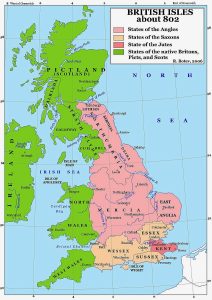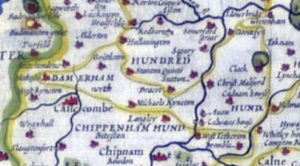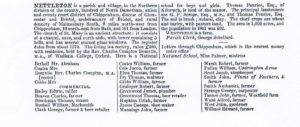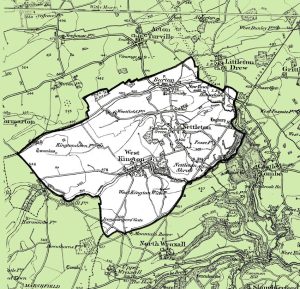Author: Chris Bennett
Wiltoniae – Wiltunscir – Wilshyre – Wilshire – Wiltshire
You know when you think you may have a bright idea and begin to wonder what the land around Burton would have looked like years & years ago, with perhaps a bit more about its history, yes of course you do. So, I set about this task and delve a little deeper into the wide variety of information sources available. What had I let myself into, which way do I go next….! The internet is a marvellous tool but how many lines of enquiry can I cope with before I realised I was beginning to lose sight of the squirrel? You may have noticed (as shown above) the number of ways the Shire/County has been spelt through the ages.
In a nutshell (no pun intended) I decided to narrow the field of information gathering and focus on some of the key stages in the evolution of Briton and then narrowing the field to Wiltshire – Nettleton – Burton, here goes….
I began by ignoring the Roman Times and anything before this and simply began with the Anglo-Saxon period in Britain which spanned approximately the six centuries from 410-1066AD. This period was known as the Dark Ages, mainly because any written sources for the early years of Saxon invasion are scarce. The below map (circa 802) shows the land areas as divided by the various inhabitants of the British Isles. As you can see Wiltshire (present day spelling) is in the far north of the Wessex area almost bordering Mercia

The history of local government in England is one of gradual change and evolution since the Middle Ages. As you probably know, England has never possessed a formal written constitution, with the result that modern administration (and the judicial system) is based on precedent, and is derived from administrative powers granted (usually by the Crown) to older systems, such as that of the Shires.
Anglo-Saxon local government (700–1066 AD)
The concept of local government in England spans back into the history of Anglo-Saxon England (c.700-1066), and certain aspects of its modern system are directly derived from this time; particularly the paradigm that towns and the countryside should be administrated separately. In this context, the feudal system introduced by the Normans, and perhaps lasting 300 years, can be seen as a ‘blip’, before earlier patterns of administration re-emerged.
The Kingdom of Wessex, c. 790 AD, was divided into administrative units known as Shires. Each Shire was governed by an Ealdorman, a major nobleman of Wessex appointed to the post by the King. The term ‘Ealdorman’ (meaning ‘elder-man’) gradually merged with the Scandinavian Eorl/Jarl (designating an important chieftain), to form the modern ‘Earl’. However, the Shires were not comparable with later Earldoms, and were not held in the Ealdorman’s own right.
The Shires of Wessex at this time have essentially survived to the present day, as counties of England (currently ceremonial counties). They included Defnascir (Devon), Sumorsaete (Somerset), Dornsaete (Dorset), Wiltunscir (Wiltshire), Hamptunscir (Hampshire). When Wessex conquered the petty kingdoms of southern England, namely Kent and that of the South Saxons, these were simply reconstituted as Shires (modern Kent and Sussex respectively).
As Wessex took over progressively larger areas of Mercia, East Anglia and Northumbria, the new lands were divided into Shires, usually named after the principal town in the new Shire; hence Northamptonshire, Oxfordshire, Derbyshire and so on. Most of the historic counties of England (and modern Ceremonial counties) south of the Mersey and Humber derive directly from this time.
Another important Shire official was the shire-reeve; the modern-day derivative is a sheriff or high sheriff. The shire-reeve was responsible for upholding the law, and holding civil and criminal courts in the Shire.
Below the level of the Shire, the Anglo-Saxon system was very different from the later systems of local government. The Shire was divided into an unlimited number of ‘hundreds’ (or wapentakes in the Danelaw counties of Yorkshire, Derbyshire, Leicestershire, Northamptonshire, Nottinghamshire, Rutland and Lincolnshire). Each ‘hundred’ consisted of 10 groups of 10 households. A group of 10 households was a tithing and each household held one hide of land. The hide was an arbitrary unit of land which was deemed able to support one household, and thus could vary in size. The whole hundred system was thus both very flexible and fluid, varying with changes in population etc.
‘Hundreds’ were led by a ‘hundred-man’, and had their own ‘hundred’ courts. The members of the ‘hundreds’ (or tithings, etc.) were collectively held responsible for each individual’s conduct, thereby decentralising the administration of justice upon the people themselves. ‘Hundreds’ were used as administrative units for the raising of armies, collection of taxes and so forth.
What is a ‘wapentake’ in England?
This is a subdivision of certain northern counties originally under Norse domination, corresponding to the hundred as used in other counties. It was also a law court in such a subdivision
Moving on from the Anglo Saxon period, we arrive at the Norman period of history. Domesday is Britain’s earliest public record. It contains the results of a huge survey of land and landholding commissioned by William I in 1085. Domesday is by the far the most complete record of pre-industrial society to survive anywhere in the world and provides a unique window on the medieval world.
Nettleton was a settlement named in the Domesday Book, located in the ‘hundred’ of Thorngrove in the county of Wiltshire (modern day spelling)
Extract from the Doomsday book records (I believe written in Latin) – Nneletone

In 1086 Nettleton had a recorded population of 24 households, putting it in the largest 40% of settlements recorded in Domesday.
There were 3 places named within the ‘hundred’ of Thorngrove in the Domesday Book. This hundred was listed as land belonging to Glastonbury (St Mary) Abbey
| Name | Households |
| [Castle] Combe | 33 |
| Nettleton | 24 |
| Grittleton | 23 |
The Households of Nettleton comprised of the following:
- 10 villagers. 12 smallholders. 2 slaves.
Land and resources
- Ploughland: 12 ploughlands. 4 lord’s plough teams. 6 men’s plough teams.
- Other resources: 10.0 lord’s lands. Meadow 4 acres. Woodland 0.5 leagues * 2 furlongs mixed measures. 3 mills, to a value of £1 2s & 5pence.
Valuation
- Annual value to lord: 13 pounds in 1086; 8 pounds when acquired by the 1086 owner.
In 1861 according to (Kelly’s directory of 1867) Nettleton was now part of the North Damerham ‘Hundred’ an area (as below bordered in yellow) which included the ancient parishes of Christian Malford, Grittleton, Kington St. Michael and Nettleton, which can be seen on the map below (near the letters of Dam) in Damerham.

The extract below provides information about the residents and occupations of Nettleton Parish (which includes the village known as Burton)

The ‘hundreds’, with a few exceptions were effectively abandoned as administrative divisions in the 19th century and we can assume this is when our present Parish Councils became the local authority within the District of North Wiltshire. During my research I was unable to find any record when this took place. Although on checking the National Census records for the area it was clear Parish records show Burton Street, Nettleton in 1861, but by 1881 we have specific entries for Burton village. The map below also seems to support this.
Map of Nettleton Parish in the 1890’s

In conclusion, it is clear Nettleton has been a named settlement as far back as the Doomsday records of 1086. However, in the 1850’s Burton was initially a street and hill within Nettleton, and it wasn’t until the 1880’s Burton was listed as a separate village, within the Parish of Nettleton.
Due to the length of this article so far, and before I go off at a tangent, I decided to draw a line at this point.
Reference Material:
https://www.british-history.ac.uk
https://opendomesday.org/county/wiltshire
Kelly’s Directory of Wiltshire 1867
Collins English Dictionary



1 Comment
From Anarchy to Unification: the Anglo-Saxons in Wiltshire - Burton in Wiltshire · 03/28/2023 at 6:21 pm
[…] For more on this period in our history, see here. […]